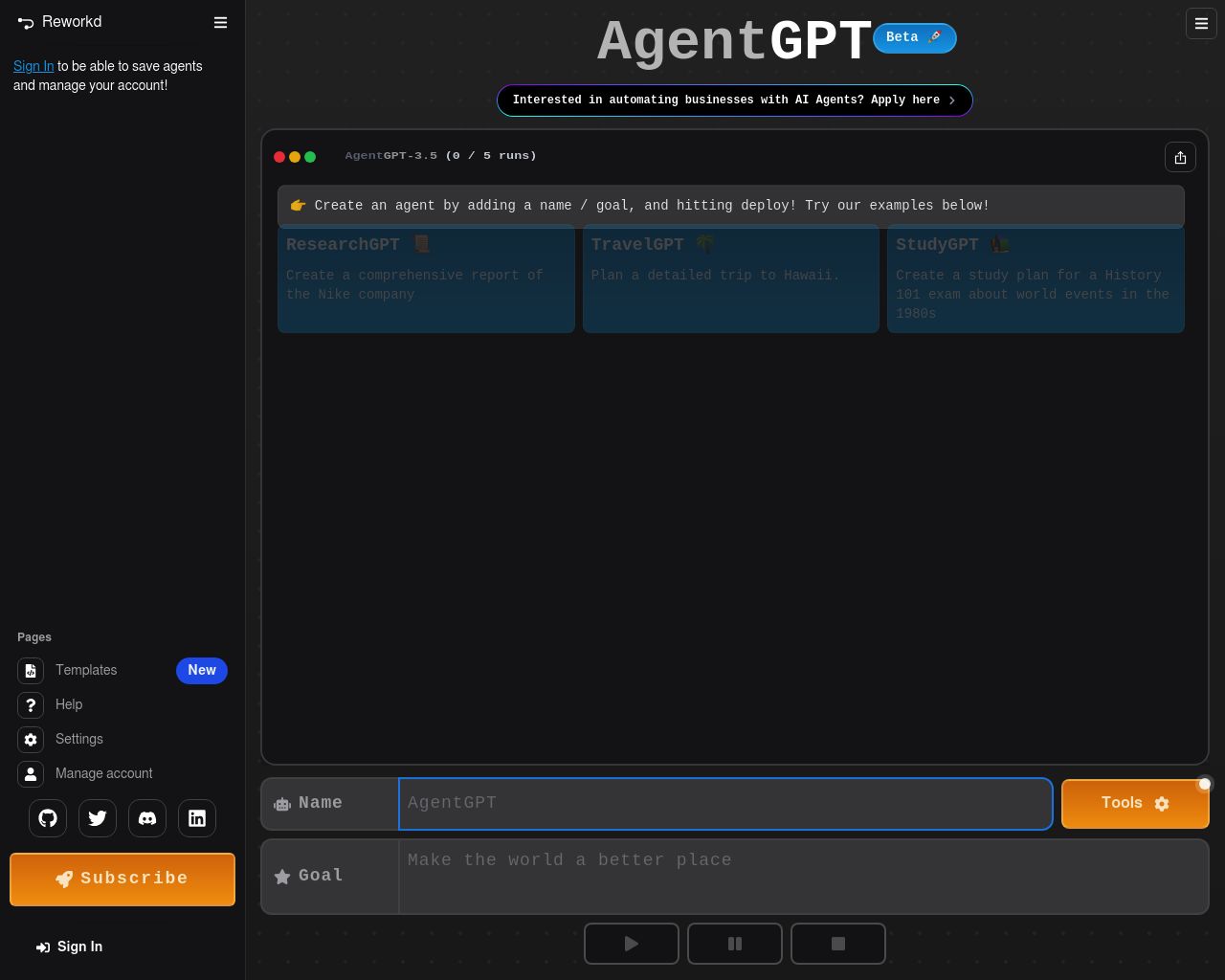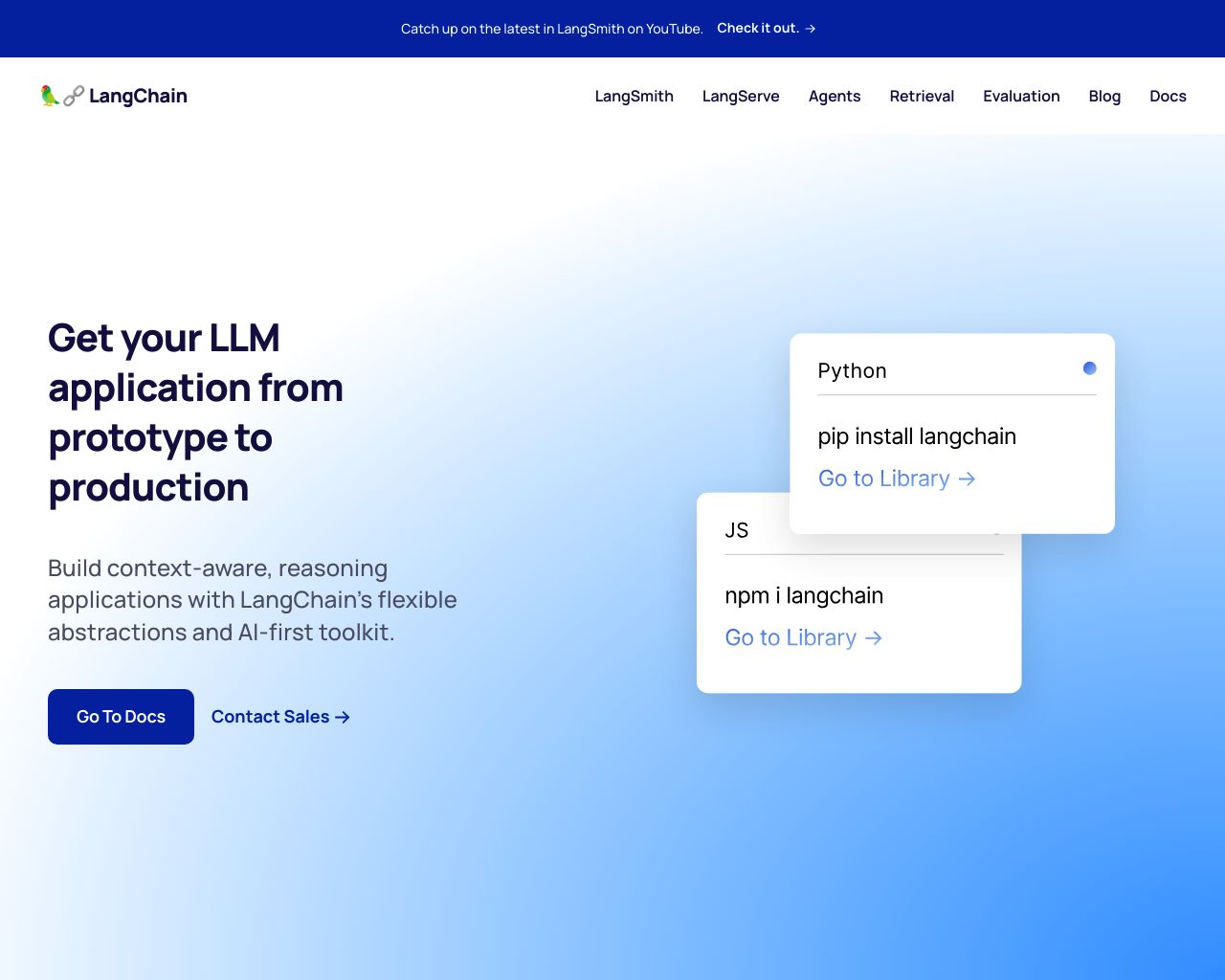AI development platforms AgentGPT and LangChain offer powerful tools for creating intelligent applications, but each comes with its own set of strengths and limitations. This comparison explores how these platforms stack up against SmythOS, a comprehensive solution that combines the best of both worlds. We’ll examine key features, ease of use, and development capabilities to help you choose the right tool for your AI projects. Whether you’re a seasoned developer or a business leader looking to harness AI’s potential, this analysis provides the insights you need to make an informed decision in today’s competitive AI landscape.
AgentGPT Overview
AgentGPT empowers users to create and deploy autonomous AI agents directly in a web environment. Unlike traditional chatbots, these agents excel at tackling broad, goal-oriented tasks with minimal human intervention.
AgentGPT empowers users to create and deploy autonomous AI agents… these agents excel at tackling broad, goal-oriented tasks with minimal human intervention.

The platform stands out with its user authentication system, agent run saving and sharing capabilities, and dynamic translations supporting multiple languages. AgentGPT leverages vector databases for advanced memory management, allowing agents to retain execution history and access long-term memory. This enhances their ability to handle complex, ongoing tasks effectively.
AgentGPT leverages vector databases for advanced memory management, allowing agents to retain execution history and access long-term memory.
Developers benefit from AgentGPT’s flexible deployment options. The platform offers local runs via docker-compose without requiring an API key, as well as scalable cloud solutions that integrate seamlessly with tools like LangChain. This versatility makes AgentGPT suitable for both individual projects and enterprise-level applications.
While AgentGPT offers powerful features, it lacks some advanced capabilities found in other platforms. The absence of a visual builder or no-code editor may present a learning curve for non-technical users. Additionally, the platform does not currently support multi-agent collaboration or provide extensive debugging tools, which could limit its application in more complex scenarios.
Despite these limitations, AgentGPT’s commitment to open-source development and continuous improvement positions it as a valuable tool for those seeking to harness the power of autonomous AI agents. Its focus on accessibility and scalability makes it an attractive option for developers and businesses looking to integrate AI into their operations efficiently.
LangChain Overview
LangChain empowers developers to build sophisticated applications powered by large language models (LLMs). This open-source framework simplifies the entire LLM application lifecycle, from development to deployment.

LangChain offers a comprehensive toolkit for AI application development. Its modular architecture includes components for prompt management, memory systems, and data processing. Developers can leverage these building blocks to create complex AI agents capable of reasoning, task planning, and information retrieval.
LangChain offers a comprehensive toolkit for AI application development… Developers can leverage these building blocks to create complex AI agents capable of reasoning, task planning, and information retrieval.
The platform shines in its ability to integrate with various data sources and third-party tools. This flexibility allows developers to create AI applications that can access and process information from diverse origins, enhancing the context and capabilities of their LLM-powered solutions.
While LangChain provides powerful tools for experienced developers, it may present a steeper learning curve for those new to AI development. The platform’s extensive documentation and active community help mitigate this challenge, but users should expect to invest time in understanding its concepts and best practices.
LangChain’s position in the AI development landscape is unique. It balances flexibility and structure, allowing developers to create highly customized AI applications while providing a framework that encourages best practices. This approach makes LangChain particularly attractive for teams looking to push the boundaries of what’s possible with LLM-powered applications.
Feature Comparison
AgentGPT and LangChain offer distinct approaches to AI development, each with its own strengths and limitations. AgentGPT excels in creating autonomous AI agents that can operate independently on broad, goal-oriented tasks. Its use of vector databases for memory management allows agents to retain execution history and access long-term memory, enhancing their ability to handle complex, ongoing tasks. However, AgentGPT lacks a visual builder or no-code editor, which may present challenges for non-technical users.
LangChain, on the other hand, provides a comprehensive toolkit for AI application development with a focus on large language models (LLMs). Its modular architecture includes components for prompt management, memory systems, and data processing, allowing developers to create sophisticated AI agents capable of reasoning and task planning. LangChain’s strength lies in its flexibility and extensive integration capabilities with various data sources and third-party tools. However, LangChain may have a steeper learning curve for those new to AI development, requiring more time investment to fully utilize its capabilities.
While both platforms offer powerful tools for AI development, SmythOS stands out by combining the strengths of both approaches. We offer a user-friendly visual builder that simplifies the creation of AI agents, making it accessible to users with varying levels of technical expertise. Our platform also provides robust integration capabilities, scalable deployment options, and advanced features like multi-agent collaboration and extensive debugging tools. This comprehensive approach positions SmythOS as a versatile solution that addresses the limitations of both AgentGPT and LangChain, making it an ideal choice for a wide range of AI development needs.
Feature Comparison Table
| AgentGPT | LangChain | SmythOS | |
|---|---|---|---|
| CORE FEATURES | |||
| Visual Builder | ❌ | ❌ | ✅ |
| No-Code Options | ❌ | ❌ | ✅ |
| Explainability & Transparency | ❌ | ✅ | ✅ |
| Human-AI Interaction | ❌ | ✅ | ✅ |
| Agent Work Scheduler | ✅ | ❌ | ✅ |
| SECURITY | |||
| Constrained Alignment | ❌ | ❌ | ✅ |
| IP Control | ❌ | ❌ | ✅ |
| COMPONENTS | |||
| Foundation AIs | ❌ | ✅ | ✅ |
| Zapier APIs | ✅ | ❌ | ✅ |
| Data Lakes | ❌ | ❌ | ✅ |
| DEPLOYMENT OPTIONS (EMBODIMENTS) | |||
| Deploy as Webhook | ✅ | ❌ | ✅ |
| Staging Domains | ❌ | ❌ | ✅ |
| Production Domains | ❌ | ❌ | ✅ |
| Deploy as Scheduled Agent | ❌ | ❌ | ✅ |
| DATA LAKE SUPPORT | |||
| Hosted Vector Database | ✅ | ❌ | ✅ |
| Sitemap Crawler | ❌ | ❌ | ✅ |
| YouTube Transcript Crawler | ❌ | ❌ | ✅ |
| URL Crawler | ✅ | ❌ | ✅ |
| Word File Support | ✅ | ❌ | ✅ |
Best Alternative to AgentGPT and LangChain
SmythOS stands out as a superior alternative to AgentGPT and LangChain for AI agent development. We combine powerful features with unmatched ease of use, offering a comprehensive platform for creating and deploying AI agents. Our visual builder simplifies agent creation, allowing users of all skill levels to design complex workflows without extensive coding. This approach democratizes AI development, making advanced capabilities accessible to a broader audience.
SmythOS stands out as a superior alternative to AgentGPT and LangChain for AI agent development. We combine powerful features with unmatched ease of use, offering a comprehensive platform for creating and deploying AI agents.
Unlike AgentGPT and LangChain, SmythOS provides a complete ecosystem for AI agent lifecycle management. We offer seamless integration with various data sources, APIs, and AI models, enabling users to build versatile agents capable of handling diverse tasks. Our platform supports multi-agent collaboration, allowing teams of AI agents to work together on complex problems, a feature not readily available in AgentGPT or LangChain.
SmythOS provides a complete ecosystem for AI agent lifecycle management… enabling users to build versatile agents capable of handling diverse tasks.
SmythOS excels in deployment flexibility, offering options to deploy agents as APIs, webhooks, scheduled tasks, or chatbots. This versatility ensures that AI solutions can be integrated into existing systems and workflows with minimal friction. Our robust debugging and monitoring tools provide unparalleled transparency and control over agent operations, addressing limitations in explainability found in other platforms.
SmythOS excels in deployment flexibility, offering options to deploy agents as APIs, webhooks, scheduled tasks, or chatbots.
Security and scalability set SmythOS apart from competitors. We implement advanced features like constrained alignment and IP control, ensuring AI agents operate within defined parameters and maintain data privacy. Our platform scales effortlessly to meet enterprise-level demands, supporting both development and production environments with dedicated staging and production domains. This comprehensive approach positions SmythOS as the ideal choice for organizations seeking a powerful, user-friendly, and scalable AI agent development solution.
Conclusion
AgentGPT and LangChain offer powerful tools for AI development, each with distinct strengths. AgentGPT excels in creating autonomous AI agents for broad, goal-oriented tasks, leveraging vector databases for advanced memory management. LangChain provides a comprehensive toolkit for LLM-powered applications, offering flexibility and extensive integration capabilities.
While both platforms have their merits, SmythOS emerges as the superior choice by combining the strengths of both approaches and addressing their limitations. We offer a user-friendly visual builder that simplifies AI agent creation, making it accessible to users of all technical levels. Our platform provides robust integration capabilities, scalable deployment options, and advanced features like multi-agent collaboration and extensive debugging tools.
SmythOS stands out with its “Create Once, Deploy Anywhere” approach, allowing users to build agents that can be easily integrated into multiple environments. Our extensive ecosystem of over 300,000 integrations enables users to orchestrate complex workflows with ease, supporting a wide range of AI models, APIs, tools, and data sources.
For those looking to harness the full potential of AI in their operations, we invite you to explore our diverse range of AI-powered agent templates. These templates cover multiple business categories and are designed to streamline processes across various functions. To experience the power of SmythOS firsthand, create a free account and start building AI agents with no time limit. Discover how SmythOS can revolutionize your approach to AI development and deployment, and join us in shaping the future of AI-powered productivity.